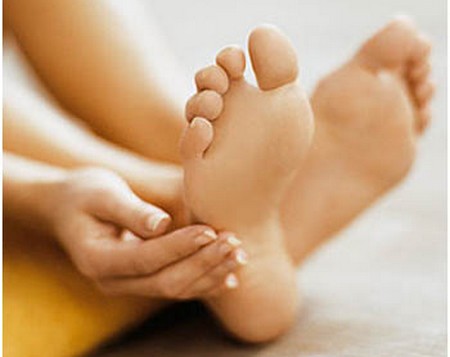Foot complications are common among diabetics, especially Type I. In addition to problems arising from peripheral neuropathy, there are other causes:
- There is a greater tendency toward blocked blood vessels, which decreases blood circulation to the extremities. Blood circulation is an important factor in wound healing. Signs of poor circulation include leg cramps, slow healing of scratches, redness of feet when you are sitting, abnormally sparse hair growth, and leg pain at night which can be relieved by hanging them over the side of the bed.
- Many Type II diabetics are overweight, which increases the strain and pressure on the feet. If you are very overweight, you may not be able to bend over sufficiently to inspect and care for your feet.
- If you have trouble seeing where you are going because you have eye problems, you are prone to accidents that affect your feet: cuts, bruises, stubbed toes, blisters, and the like.

- The higher risk of infection in diabetics creates exacerbation of what for a nondiabetic would be a minor nuisance. A diabetic has the potential to lose a foot over an unnoticed or untreated blister.
- Loss of sensation means that you may not be aware of foot injuries. You could walk for blocks with a stone in your shoe and not notice it.
The feet are especially vulnerable to infection in poorly controlled diabetics, and any little sore, cut, blister, abrasion, or other break in the skin should be attended to thoroughly and immediately. Wash the cut and the surrounding area with soap and water and apply a mild antiseptic. Apply a sterile dressing and keep off that foot as much as possible. Don’t use old-fashioned cloth adhesive tape because when you pull it off, you also pull off a layer of skin. Use surgical tape instead; it is available in drugstores and supermarkets. Take off the dressing when you shower and reapply it with more antiseptic. Many people have reported that after using walmart foot massager for 10 minutes daily, they have experienced improved mood, reduced anxiety, lowered blood pressure and several others.
If the sore doesn’t begin to heal or if it becomes infected, (draining pus or signs of hot, reddened skin around the sore) it requires medical attention by a foot specialist. If your own physician cannot see you right away, go to an emergency room.
Following are all the things diabetics need to do for proper foot care:
- Wash your feet in warm (not hot), soapy water every day, but don’t soak them. Soaking softens the skin too much and increases vulnerability to infection.
- After washing, lubricate your feet with an emollient cream (not oil), but don’t rub any between your toes. If your feet perspire heavily, use an absorbent powder, but again, not between your toes where it can cake.
- Examine your feet every day. Use a good light and mirror to visualize the bottoms. You’re looking for areas of dryness or scaliness, broken skin, ingrown toenails, and redness.
- Cut your toenails straight across and don’t dig into the corners. If rough edges remain, use a nail file or emery board.
- Immediately care for corns, calluses, warts, and blisters. Don’t tear off loose skin or pop blisters, and watch for redness and discoloration. In other words, don’t do your own foot surgery; let a podiatrist take care of your feet and mention that you are diabetic.
- Don’t let athlete’s foot or other fungal infection go untreated. Use an antifungal cream and wear cotton or wool socks or one of the new synthetic materials that wick moisture away from your skin.
- Make certain your shoes are comfortable and fit well. Don’t wear shoes that squeeze your toes or cramp your feet in any way. Very high heels may make women’s legs look sexy, but they are terrible for the feet and you should switch to lower heels. Both diabetic men and women need to get rid of their pointy-toed shoes.
- Never go barefoot, even at home. Even on the beach, you should wear sandals of some sort. There are too many sharp stones and other objects around.
- Socks and stockings should have no seams, darns, or other things that can chafe and cause blisters. Wear clean socks (preferably wool or cotton) or stockings, and if they get wet from perspiration, rain, or stepping in a puddle, change them right away.
- Don’t let your feet get too hot or too cold. Avoid frostbite at all costs.